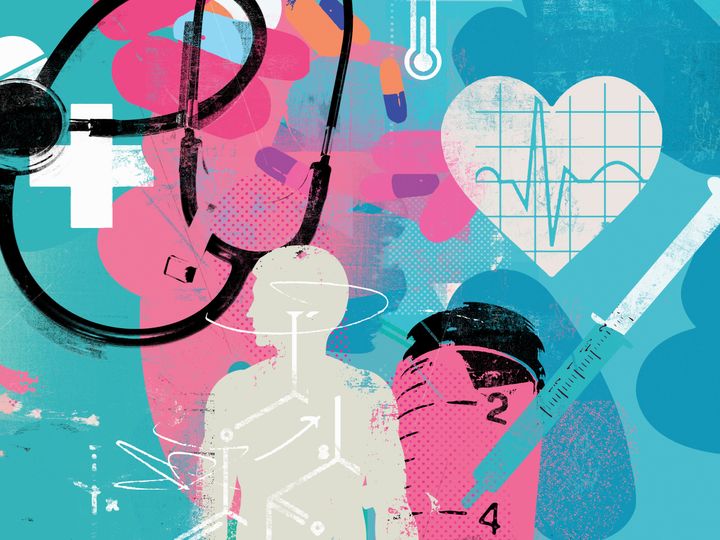“I’ve always been anti-drugs all my life, it’s just the way I was brought up,” says Mike, 37, from Manchester. “But then I found myself asking people: ‘Do you know anyone selling?’”
In 2008, Mike was given a prescription for codeine by his GP to help ease the pain he was experiencing while recovering from a broken hand. What followed was a nine-year battle with addiction to the drug, a form of opioid, which cost him his driving licence, his relationships with friends and family, and almost lost him his job. “It can ruin lives,” he says.
There’s currently no clear data available on codeine misuse in the UK – Public Health England is conducting a review of prescription drug addiction, which is due to be published later this year.
But data shared exclusively with HuffPost UK by UKAT, a chain of private treatment centres, suggests a 45% rise in admissions for codeine addiction in the past three years. In 2018, 113 people were admitted for prescription drug misuse up from 101 in 2015. Among those, 35 in 2018 were dependent on codeine specifically, up from 24 in 2015.
The figures may be from one chain of private clinics, but academics working in the field say they reflect anecdotal evidence of a growing problem. Eytan Alexander, founder of UKAT, thinks the rise is “extremely worrying”.
“More and more people are misusing codeine to the point where they develop a physical and psychological dependency,” he says. “At UKAT, we’re concerned that society hasn’t accepted codeine as a dangerous drug. The truth is that it is part of the same family as heroin and needs to be taken as seriously to avoid a potential future epidemic.”

Codeine works by stopping pain signals from travelling along the nerves to the brain. Although strong codeine is only available on prescription, lower strength codeine is available from pharmacies and is mixed with paracetamol (co-codamol), with aspirin (co-codaprin) or with ibuprofen. It’s marketed as a painkiller for everything from migraines to period pain. Recreational users also obtain the drug illegally from dealers or online.
Patients prescribed codeine for pain issues report enjoying the sensation of the drug, a factor which may have contributed towards the number of people switching from medical to recreational use.
“I was at rock bottom, I was having suicidal tendencies and I thought: something’s got to give, I have to change this.””
- Mike
Mike, who recently celebrated one year clean of the painkiller, says: “At the time I didn’t realise I had an underlying anxiety issue. Codeine made me feel less anxious. It made me feel really calm and like my head went warm. It’s a really nice feeling.”
But over time, his codeine misuse grew into an addiction that began impacting all parts of his life. “Everything changed, I would be going to watch football, hanging out with mates, and then suddenly I just stopped doing everything. It killed my sex drive, amongst killing all interests. Even my hygiene dropped,” he says. “I was at rock bottom, I was having suicidal tendencies and I thought: something’s got to give, I have to change this.”
Tolerance to the drug can build up, so patients or recreational users have to take more to get the same effects or to avoid withdrawal symptoms such as nervous tremors, anxiety, sleep disorders, vomiting and diarrhoea.
Like Mike, Adam, now 26, from south west Scotland, developed an addiction to codeine after he was prescribed it, in his case while he was recovering from knee reconstruction surgery when he was a 19-year-old student.
“In the beginning I took the prescribed amount which seemed to dull my senses enough,” he recalls. ”After a couple of months I was having to take more than the prescribed amount to have the same effect. I had no concern about developing an addiction as it had been prescribed. I was only told to take them when I felt particularly sore, no mention of addiction.”
Adam took codeine for around a year before weaning himself off the drug when he realised he was growing dependent. But last year his GP re-prescribed codeine while he awaits a hip operation. “I’m not in great pain,” he says. “I take them purely for pleasure now.

Despite the lack of official nationwide data, do stories like Mike and Adam’s suggest codeine addiction is on the rise in the UK?
“I definitely think so,” says Dr Li-Chia Chen, a senior lecturer at Manchester University, who has conducted research into global opioid prescriptions. “But obviously whatever I think is purely based on the drugs utilisation research conducted, and so it’s so anecdotal, from very fragmented data.”
The opioid crisis in the US – where 130 people are dying every day from opioid overdoses – is well documented academically, with news headlines to match, but Dr Roger Knaggs, associate professor at the University of Nottingham, explains it’s simply not possible to track misuse in the UK with current systems.
“Because most healthcare is funded by insurance in the States, they have very good patient level data that crosses between primary care and secondary care,” he says. “But in the UK, we don’t have one record that transfers wherever people are seen, so that means tracking these issues is really quite difficult.”
The latest data from the Office of National Statistics shows deaths caused by codeine in England and Wales increased from 131 in 2016 to 156 in 2017, an increase of nearly 20%. But Dr Knaggs says these figures still pale in comparison to the US. Dr Chen argues one potential reason for this could be that initial opioid prescriptions are often much stronger in the US than the UK.
Nevertheless, the number of opioid drugs being prescribed in the UK is increasing, something both Chen and Knaggs are worried about.

Last year, a study led by University College London found the number of opioid drugs being prescribed to patients in England has been steadily rising since 2010 and notably, “prescriptions of codeine increased faster than all other opioids”.
And a recent study co-authored by Dr Chen, Dr Knaggs and colleagues found GPs in poorer areas are more likely to prescribe opioids than those in more affluent ones. They’ve called for further research into why this is the case.
But both studies paint a limited picture, as they do not include over-the-counter figures or detail how codeine and other opioids can be obtained illegally, meaning figures of consumption and misuse could actually be far higher.
“A recent study found GPs in poorer areas are more likely to prescribe opioids than those in more affluent ones”
Sarah, 31, from North Yorkshire, took codeine for wisdom tooth and period pain when she was 18 and found the drug elsewhere when she could no longer obtain a repeat prescription.
“My partner at the time worked in healthcare and had access to slightly stronger stuff than what you can buy over the counter,” she says. Although she was able to stop taking the drug without severe withdrawal symptoms, she did worry about addiction because of the “buzz” it gave her, and now only uses codeine-based products from pharmacies once or twice per year.
Mike also obtained strong doses of codeine from someone who worked in a hospital. When that source dried up, he fed his addiction by purchasing multiple over-the-counter products – such as co-codamol – and mixing them. He believes the problem is more prevalent in Manchester than reports currently suggest.
“When I was going to the pharmacy, people in the queue in front of me were buying it. When I was walking away, I could hear the person after me buying it,” he says. “There’s people around the country trying to get codeine but poisoning themselves with paracetamol on top – they don’t even want the paracetamol.”
Adam believes it should also be harder to obtain codeine from GPs that is currently the case: “I was given boxes of 100 pills at a time and all I had to do was call up my GP for a telephone appointment, explain that I had ran out and a prescription would be waiting for me at the surgery. To almost give an unlimited supply is dangerous and negligent if it’s not being monitored.”
Professor Helen Stokes-Lampard, chair of the Royal College of GPs, says drugs containing codeine can be of benefit to patients who are suffering from short-term pain, but should only be used if everyday painkillers such as paracetamol or ibuprofen haven’t worked.
“When codeine or other opiates are prescribed by a healthcare professional, it should be done so at the lowest possible dose for the shortest possible time,” she says. “For patients who are being prescribed codeine long-term, best clinical practice is to conduct regular medication reviews, at least annually, to ensure the patient is still benefiting from the medication, and discuss any circumstances that may change their treatment plan with a view to reducing medication requirements where possible.”
She adds that GPs will be “acutely aware of the potentially addictive effects of codeine”. But when taken correctly, codeine can enable people with chronic conditions to have a better quality of life.
Catherine, 37, from Hampshire, takes pharmacy own-brand paracetamol and codeine combined painkiller to help her deal with endometriosis pain. She’s been taking the medication around twice a month for 11 years and is careful not to up her dosage due to the risks clearly outlined on the packaging. Although she describes being on the drug as giving her a “tripping” sensation that makes her “toes and fingers tingle”, she has not noticed any signs of addiction.
“I rarely take it during the day and never drive or work after taking it. Mostly, I use it to manage pain at night so I can sleep,” she says. “It makes a huge difference. I’ve tried taking both paracetamol and ibuprofen but they aren’t strong enough. Without codeine, I’d likely end up in A&E once a month.”
“We need to look a much broader strategy to managing pain, looking at emotions, your thoughts and feelings about pain, as well as the pain itself."”
- Dr Roger Knaggs
Public Health England is currently conducting a review of prescription medicines that may cause dependence or withdrawal, and although this was originally scheduled for release in early 2019, a spokesperson told HuffPost UK it now won’t be available until the summer.
But Dr Knaggs, who is chair of the UK Clinical Pharmacy Association pain management group, believes the real problem stems from poor understanding of pain management in medicine. He believes we need to “reset” the way we tackle chronic pain, rather than relying on increasingly strong medication.
“We need to look a much broader strategy to managing pain, looking at emotions, your thoughts and feelings about pain, as well as the pain itself,” he says.
He also points out that while the Medicines and Healthcare Products Regulatory Agency (MHRA) stipulates that addiction warnings are marked on the packaging of over-the-counter codeine-based products, there is currently no law stipulating that these warnings must appear on prescription medication.

Mike would like to see improved support services for those who’ve developed addictions. He told his GP he was misusing codeine, but this resulted in his GP informing the DVLA and his driving license being revoked for 18 months. He was referred on to an addiction programme, but at the time he was too angry to fully engage with it. “I wished I’d just kept my mouth shut and didn’t tell him anything,” he says.
It wasn’t until 2017 that he decided to quit for good, reducing his intake bit by bit and struggling with severe withdrawal symptoms alone, because by this point, he didn’t trust health services to help him.
With his life now back on track, Mike no longer holds a grudge and does think his GP made the correct decision with the options available. But he would like to see public awareness campaigns to educate more people about the risks of codeine.
“At the end of the day, you’re an adult, and it’s down to you to act responsibly. You could go home and drink a bottle of vodka tonight, but most of us don’t,” he says. “I‘ve got nothing against the doctor who gave me the tablets to start off with – I abused them. But I’d love to see more people talking about this so others don’t do the same.”